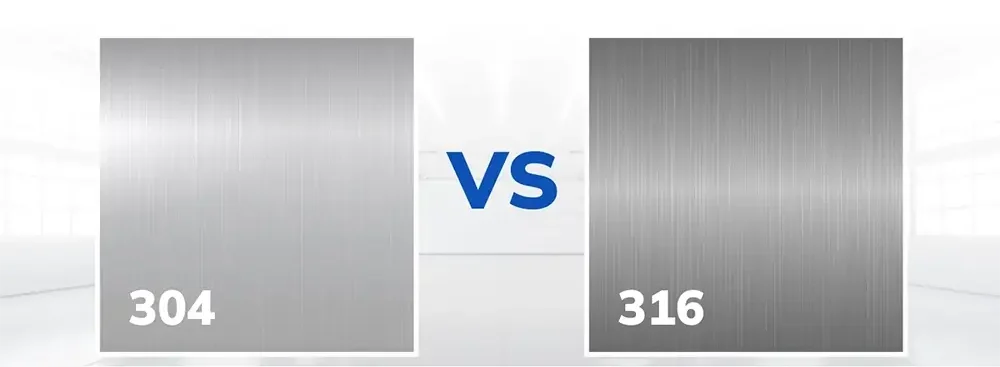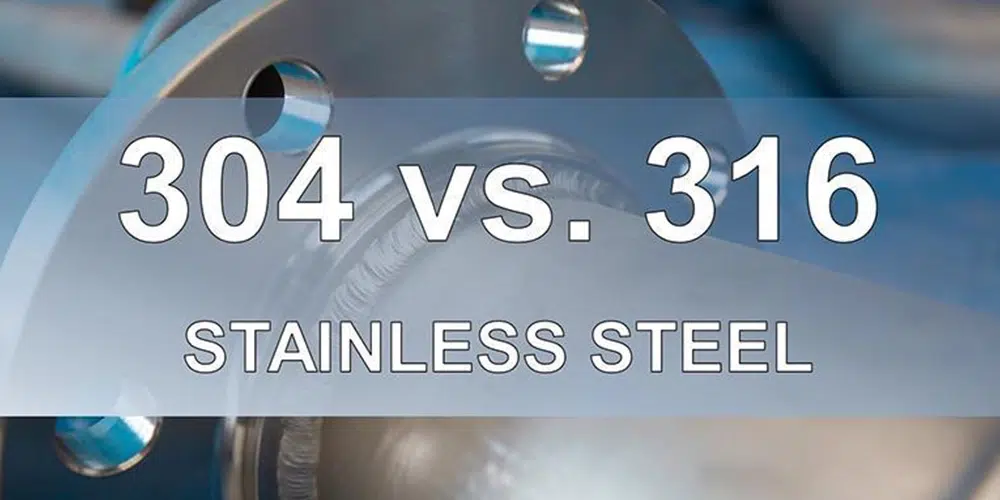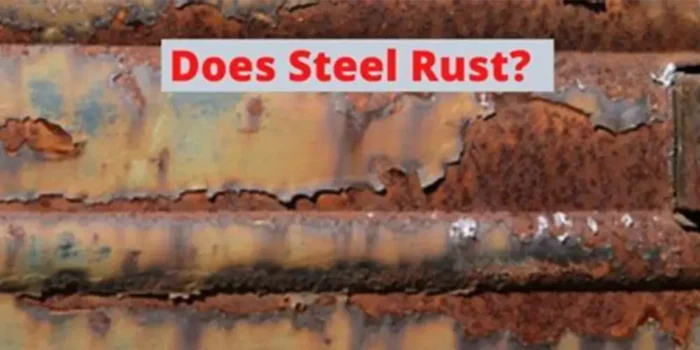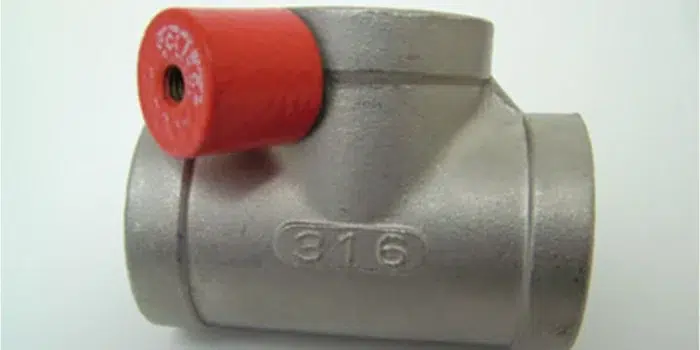現在、競争の激しい製造環境では、ステンレス鋼 の適切なグレードを選択することが組織の成 功に不可欠である。マッキンゼーの最新の市場分析と業界洞察によると、世界のステンレス鋼市場は2030年までに$1,574億ドルに達すると予想され、304と316ステンレス鋼が最も重要な2つの鋼種であり、それぞれ環境や要件に応じて独自の利点を備えている。
違い:304対316ステンレス鋼
316と304ステンレス鋼は、オーステナイト系ステンレス鋼に属し、世界で最も広く使用されている2つのグレードであり、優れた耐食性を提供します。

304ステンレス鋼
Containing 16 to 24 percent chromium and small amounts of carbon and manganese, 304ステンレス鋼 is the most common 18-8 stainless steel, which contains 18 percent chromium and 8 percent nickel.
316ステンレス鋼
Grade 316 has virtually the same physical and mechanical properties as 304ステンレス鋼, with the main difference being that 316ステンレス鋼 contains 2% to 3% molybdenum, which improves corrosion resistance, especially against chlorides and other industrial solvents.
| 素材 構成 | 304 | 316 |
| C | ≤0.08 | ≤0.08 |
| Si | ≤1.00 | ≤1.00 |
| ムン | ≤2.00 | ≤2.00 |
| P | ≤0.045 | ≤0.045 |
| S | ≤0.030 | ≤0.030 |
| Cr | 18-20 | 16-18 |
| N | 8-10.5 | 10-14 |
| モ | - | 2.0-3.0 |
約8%のニッケルを含む304や約10%の316では、オーステナイト組織を安定させ、加工や高応力用途に不可欠な延性と靭性を確保する。
Nickel also significantly boosts corrosion resistance, especially against reducing acids and chloride-induced stress-corrosion cracking.316 stainless steel also contains 2 to 3% molybdenum than 304ステンレス鋼, making it resistant to corrosion from chlorides, such as seawater and ice salts, outshining 304 in saline and harsh chemical environments.
Nickel plays a critical role in both 304 and 316ステンレス鋼, but the differences in nickel content, and the addition of molybdenum in 316 directly influence their performance under extreme conditions.
| グレード | 202 | 304 |
| 引張強度 | ≥520 | ≥520 |
| 降伏強度 | ≥205 | ≥205 |
| エクステンション | ≥30% | ≥35% |
| 硬度(HV) | <253 | <200 |
両鋼種とも引張強さと優れた剛性(弾性率:304は193-200GPa)は同様ですが、ニッケル(10-14%)とモリブデン(2%)が高いため、特に高圧環境や塩化物が多い環境では、316鋼の耐割れ性、耐孔食性、耐腐食性が著しく向上します。
熱的にニッケルは安定性を向上させる。316の組成は、熱交換器や化学反応器のような高温下での長時間の使用に耐える信頼性を高めている。
304は性能もよく、費用対効果も高いが、モリブデンを含まないため、過酷な条件や変動する条件には不向きである。
316は過酷な環境で輝きを放ち、304はそれほど要求の厳しくない用途に適している。
耐食性
316の方がいい:
モリブデンにより、塩素環境(海水、塩水)、酸性媒体、高温環境での耐食性に優れ、孔食や粒界腐食に対する耐性は304よりも優れている。
304は一般的な環境に適している:
日常的な環境での耐食性は良好だが、高塩素や酸性の環境では腐食しやすい。
The difference in corrosion resistance between 316 and 304ステンレス鋼 is primarily due to their alloying elements. 316ステンレス鋼 contains a minimum of 2.0% molybdenum, which significantly enhances its corrosion resistance, especially in chloride-rich environments, such as those found in marine applications.
The addition allows 316 to withstand exposure to salt and other corrosives far better than 304ステンレス鋼, which lacks molybdenum and therefore is more susceptible to pitting and crevice corrosion in salty environments
より過酷な環境、特に塩化物や酸を含む環境に対応する場合は、316が優れた選択肢となり、耐久性と寿命が向上します。
機械的特性
Both 304 and 316ステンレス鋼 are tough, ductile austenitic alloys. In practice, 316 often shows slightly higher tensile and yield strength due to its alloy content. For example, typical data show 316 UTS ≈79.8 ksi vs 73.2 ksi for 304, and yield ≈34.8 ksi vs 31.2 ksi.
伸びは同程度(60-70% 程度)。どちらの鋼種も高温下でも強度を維持しますが、通常316は高温下でもやや強度を維持します。
316ステンレス鋼 is generally recognized for its superior mechanical strength compared to 304, making it more suitable for applications requiring high tensile strength and hardness.However, 304ステンレス鋼 exhibits greater flexibility due to its lower modulus of elasticity, which can be advantageous in specific fabrication processes
In terms of machinability, 304ステンレス鋼 is easier to machine than 316, largely due to its lower hardness. This ease of machining can reduce tool wear and operational downtime.
When exposed to high temperatures, 304ステンレス鋼 can withstand elevated temperatures well, but continuous use at temperatures between 425-860 °C (797-1580 °F) may lead to corrosion.In contrast,316ステンレス鋼 maintains its strength and corrosion resistance even at elevated temperatures, making it a preferred choice for heat applications.
コスト
グレード316 は一貫して304 よりも割高である。主な要因は、合金含有量 - Moと高いNi - 高価で市場の影響を受けやすい - 現在の市場では、316は一般的に304よりも約20〜30%高い(国や製品形態によって異なる)。
- 304ステンレス鋼: Suitable for general applications with excellent price/performance ratio.More affordable, ideal for budget-sensitive projects.
- 316ステンレス鋼: Suitable for harsh environments with excellent corrosion resistance. Higher price due to molybdenum, but worth it for durability.
申し込み
316ステンレス鋼
316ステンレス鋼 is often recommended for harsh environments due to its superior corrosion resistance, particularly against chlorides and acids. This makes it ideal for marine applications, chemical processing, and environments with high salinity, such as coastal areas and swimming pools.
316に最低2.0%のモリブデンを添加することで、耐久性が向上し、高温下でも強度と耐食性を維持することができます。
304ステンレス鋼
304ステンレス鋼 is a more cost-effective option suitable for general applications, such as kitchen sinks, saucepans, and architectural panelling, where exposure to corrosive elements is minimal.
様々な環境下で優れた耐食性を発揮するが、より要求の厳しい用途に必要な特定の特性には欠ける。
The choice between 316 and 304ステンレス鋼 should be determined by the specific requirements of the application and the environmental conditions it will be exposed to.

304ステンレス鋼を選ぶとき
以下の品目に使用する場合は、等級304 を選ぶこと:
- 屋内または軽度の腐食環境。
- 品質に妥協することなく、予算の制約。
- 食品加工や医療機器などの用途では、極端な耐食性は要求されない。
- 一般的な建築または装飾用途
316ステンレスを選ぶとき
以下のプロジェクトに使用する場合は、316 グレードを選択すること:
- 海水または海洋環境にさらされる。
- 化学処理または酸性条件。
- 高温用途(熱交換器など)。
- 特別な耐久性と長寿命を必要とする場面。
マッキンゼーの分析から得られる主なもの
マッキンゼーの市場洞察によれば、両グレードは汎用性が高いが、市場での用途は異なる:
- 316は、その高い耐久性により、海洋、化学、エネルギーなどの分野で優位を占めている。
- 304は、建設、食品加工、ヘルスケアなど、コストと一般的なパフォーマンスが優先される分野でリードしている。
316と304ステンレス鋼はどちらが良いですか?
プロジェクトの環境と予算による:
- 過酷な条件下では、316は投資に値する。
- 一般的な用途では、304は優れた価値を提供する。
耐食性
- 腐食リスクが高い:長寿命を保証し、海洋や化学プラントのような塩化物の多い過酷な環境でも優れた性能を発揮するために316を選択する。
- 軽度の腐食:コストを節約し、汎用性を維持するために304を選択するが、極端な腐食ではあまり性能を発揮しない。
よくある誤解
316の方が常に優れている」という考えは、完全に正しいとは言えません。316の耐食性は、過酷な環境においてのみ意味を持つ。屋内または温和な環境では、316への "アップグレード "はほとんど利点を提供し、大幅なコスト増をもたらします。304で十分な場合に316を使用すると、寿命を延ばすことなく、材料や製造コストを増加させる可能性があります。一般的に:材料が塩水、除氷塩または強酸にさらされない場合は、304は、通常、十分である。
結論
要約すると、304と316ステンレス鋼は、それぞれ の特徴を持っている。グレード316は、優れた耐食性 (特に塩化物)と高い強度を提供するが、価格プレミアムが大きい。グレード304は、一般的な使 用には費用対効果が高く、非攻撃的な環 境では高い耐食性を維持する。




